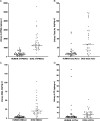Environmental chemical exposures in the urine of dogs and people sharing the same households
- PMID: 33948275
- PMCID: PMC8057441
- DOI: 10.1017/cts.2020.548
Environmental chemical exposures in the urine of dogs and people sharing the same households
Abstract
Introduction: Urothelial carcinoma (UCC) develops in both humans and dogs and tracks to regions of high industrial activity. We hypothesize that dogs with UCC may act as sentinels for human urothelial carcinogen exposures. The aim of this pilot study was to determine whether healthy people and dogs in the same households share urinary exposures to potentially mutagenic chemical carcinogens.
Methods: We measured urinary concentrations of acrolein (as its metabolite 3-HPMA), arsenic species, 4-aminobiphenyl, and 4-chlorophenol (a metabolite of the phenoxyherbicide 2,4-D) in healthy dogs and their owners. We assessed possible chemical sources through questionnaires and screened for urothelial DNA damage using the micronucleus assay.
Results: Biomarkers of urinary exposure to acrolein, arsenic, and 4-chlorophenol were found in the urine of 42 pet dogs and 42 owners, with 4-aminobiphenyl detected sporadically. Creatinine-adjusted urinary chemical concentrations were significantly higher, by 2.8- to 6.2-fold, in dogs compared to humans. Correlations were found for 3-HPMA (r = 0.32, P = 0.04) and monomethylarsonic acid (r = 0.37, P = 0.02) between people and their dogs. Voided urothelial cell yields were inadequate to quantify DNA damage, and questionnaires did not reveal significant associations with urinary chemical concentrations.
Conclusions: Healthy humans and pet dogs have shared urinary exposures to known mutagenic chemicals, with significantly higher levels in dogs. Higher urinary exposures to acrolein and arsenic in dogs correlate to higher exposures in their owners. Follow-up studies will assess the mutagenic potential of these levels in vitro and measure these biomarkers in owners of dogs with UCC.
Keywords: Bladder cancer; chemical mutagens; household exposure; one health; sentinel.
© The Association for Clinical and Translational Science 2020.
Conflict of interest statement
The authors have no conflicts of interest to declare.
Figures


Similar articles
-
Urothelial genotoxicity of environmental chemicals detected in the urine of healthy dogs and their owners.J Clin Transl Sci. 2024 Oct 24;8(1):e172. doi: 10.1017/cts.2024.546. eCollection 2024. J Clin Transl Sci. 2024. PMID: 39619067 Free PMC article.
-
Urinary and household chemical exposures in pet dogs with urothelial cell carcinoma.Vet Comp Oncol. 2024 Jun;22(2):217-229. doi: 10.1111/vco.12968. Epub 2024 Feb 22. Vet Comp Oncol. 2024. PMID: 38388159
-
Environmental exposure to human carcinogens in teenagers and the association with DNA damage.Environ Res. 2017 Jan;152:165-174. doi: 10.1016/j.envres.2016.10.012. Epub 2016 Oct 20. Environ Res. 2017. PMID: 27771571
-
Environmental and chemical carcinogenesis.Semin Cancer Biol. 2004 Dec;14(6):473-86. doi: 10.1016/j.semcancer.2004.06.010. Semin Cancer Biol. 2004. PMID: 15489140 Review.
-
Rationale for selecting exfoliated bladder cell micronuclei as potential biomarkers for arsenic genotoxicity.J Toxicol Environ Health. 1993 Oct-Nov;40(2-3):223-34. doi: 10.1080/15287399309531790. J Toxicol Environ Health. 1993. PMID: 8230298 Review.
Cited by
-
DNA damage response proteins in canine cancer as potential research targets in comparative oncology.Vet Comp Oncol. 2022 Jun;20(2):347-361. doi: 10.1111/vco.12795. Epub 2022 Jan 10. Vet Comp Oncol. 2022. PMID: 34923737 Free PMC article. Review.
-
Urothelial genotoxicity of environmental chemicals detected in the urine of healthy dogs and their owners.J Clin Transl Sci. 2024 Oct 24;8(1):e172. doi: 10.1017/cts.2024.546. eCollection 2024. J Clin Transl Sci. 2024. PMID: 39619067 Free PMC article.
-
How can we achieve more accurate reporting of average dog lifespan?J Am Vet Med Assoc. 2024 Jun 12;262(9):1-5. doi: 10.2460/javma.24.01.0068. Print 2024 Sep 1. J Am Vet Med Assoc. 2024. PMID: 38866045 Free PMC article. Review.
-
Pesticides and Bladder Cancer: Mechanisms Leading to Anti-Cancer Drug Chemoresistance and New Chemosensitization Strategies.Int J Mol Sci. 2023 Jul 13;24(14):11395. doi: 10.3390/ijms241411395. Int J Mol Sci. 2023. PMID: 37511154 Free PMC article. Review.
-
Genotoxic Herbicide Exposures in Golden Retrievers With and Without Multicentric Lymphoma.Vet Comp Oncol. 2025 Jun;23(2):246-256. doi: 10.1111/vco.13051. Epub 2025 Mar 21. Vet Comp Oncol. 2025. PMID: 40114542 Free PMC article.
References
-
- Jung I, Messing E. Molecular mechanisms and pathways in bladder cancer development and progression. Cancer Control 2000; 7: 325–334. - PubMed
-
- Wu XR. Urothelial tumorigenesis: a tale of divergent pathways. Nature Reviews Cancer 2005; 5: 713–725. - PubMed
-
- Vineis P, Simonato L. Proportion of lung and bladder cancers in males resulting from occupation: a systematic approach. Archives of Environmental Health 1991; 46: 6–15. - PubMed
LinkOut - more resources
Full Text Sources
